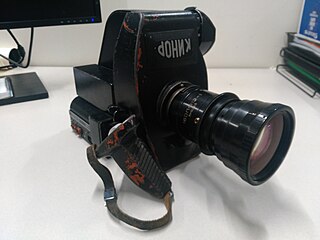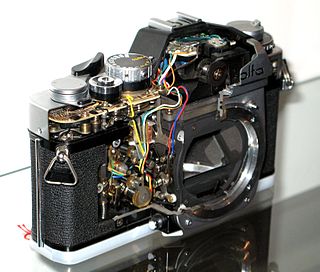
Minolta Co., Ltd. was a Japanese manufacturer of cameras, camera accessories, photocopiers, fax machines, and laser printers. Minolta Co., Ltd., which is also known simply as Minolta, was founded in Osaka, Japan, in 1928 as Nichi-Doku Shashinki Shōten. It made the first integrated autofocus 35 mm SLR camera system. In 1931, the company adopted its final name, an acronym for "Mechanism, Instruments, Optics, and Lenses by Tashima".

Contax began as a German camera model in the Zeiss Ikon line in 1932, and later became a brand name. The early cameras were among the finest in the world, typically featuring high quality Zeiss interchangeable lenses. The final products under the Contax name were a line of 35 mm, medium format, and digital cameras engineered and manufactured by Japanese multinational Kyocera, and featuring modern Zeiss optics. In 2005, Kyocera announced that it would no longer produce Contax cameras. The rights to the brand are currently part of Carl Zeiss AG, but no Contax cameras are currently in production, and the brand is considered dormant.
Cinema Products Corporation was an American manufacturer of motion picture camera equipment.

Arri Group is a German manufacturer of motion picture film equipment. Based in Munich, the company was founded in 1917. It produces professional motion picture cameras, lenses, lighting and post-production equipment. It is cited by Hermann Simon as an example of a "hidden champion". The Arri Alexa camera system was used to shoot several films that won the Academy Award for Best Cinematography, including Hugo (2011), Life of Pi (2012), Gravity (2013), Birdman (2014), The Revenant (2015) and 1917 (2019).
The Arriflex D-20 is a film-style digital motion picture camera made by Arri first introduced in November 2005. The camera's attributes are its optical viewfinder, modularity, and 35mm-width CMOS sensor. The camera was discontinued in 2008 when its successor, the Arriflex D-21, was introduced.
The Arriflex 435 is a movie camera product line created by Arri in 1995 to replace the Arriflex 35-III line. The number reflects its position as a successor camera to the Arri III and the fact that it is designed for 35 mm film. The 435 cameras are specifically designed as MOS cameras, which means that they are conventionally considered to be too loud to record usable location sound. However, this also frees the camera up to be optimized for non-sync sound uses, particularly any filming which either doesn't require sound or shooting at non-sync speed, shooting in reverse, or ramping between different speeds. As such, its potential applications are widespread, and thus it is regularly used on music videos, commercials, second unit work on features, special effects work, and motion control, among other usage. Rival Panavision even owns more 435s for rental than Arri's own hire houses; Panavisions, however, can be converted to Pan-Arri 435s where they are modified to accept Panavision lenses and accessories. In recognition of the achievements of the 435 system, AMPAS awarded Arri a Scientific and Engineering Academy Award in 1999.
This article summarized the comparison of movie cameras.
The Arriflex 35 was the first reflex 35mm production motion picture camera, released by German manufacturer Arri in 1937.

Kinor is the name of a line of movie cameras produced in the USSR. All cameras under the Kinor name were intended for professional use and were equipped with a through-the-lens viewfinder with a mirror shutter, but were otherwise unrelated in their technical design as they were created by a variety of different organizations.

The Konica Hexar RF is a 35 mm rangefinder camera which was sold by Konica. It was introduced to the market on 13 October 1999. and subsequently discontinued some time before the end of 2003. The camera used the "Bayonet Konica KM-mount", a copy of the Leica M-mount, thus sharing interchangeable lenses with those designed for Leica cameras and others compatible with them. The Hexar RF has a combined rangefinder/viewfinder modeled on that of Leica cameras, a similar body shape and size - and so is similar to Leica M-mount cameras in many aspects of operation.

The Pentax MG is an entry-level, interchangeable lens, 35mm film, single-lens reflex (SLR) camera manufactured by Asahi Optical Co., Ltd. from 1981 to 1985. It was introduced as the successor to the Pentax MV and MV1 cameras.

The Minolta SR-mount was the bayonet mounting system used in all 35 mm SLR cameras made by Minolta with interchangeable manual focusing lenses. Several iterations of the mounting were produced over the decades, and as a result, the mount itself was sometimes referred to by the name of the corresponding lens generation instead.
Arriflex 416 is a motion picture camera product line created by Arri in 2006. This camera line was introduced in large part to accommodate new lenses of larger diameter that physically interfered with the Arri 16 SR3 viewfinder. The 416 camera series is designed for 16mm filmmaking in the Super 16 format. The 416 series has some features that are derived from Arri's 35mm cameras. The 416 series is compatible with some 35mm camera accessories, such as PL-mount lenses, base plates, matte boxes, follow focus units, and more.
This article discusses the cameras – mainly 35 mm SLRs – manufactured by Pentax Ricoh Imaging Corp. and its predecessors, Pentax Corporation and Asahi Optical Co., Ltd.. Pentax must not be confused with Pentax 6x7 or Pentax 67 which are 120 medium format 6x7cm film cameras.

The Arri Alexa is a digital motion picture camera system developed by Arri. The Arri Alexa was introduced in April 2010 and was Arri's first major transition into digital cinematography, after previous efforts including the Arriflex D-20 and D-21.

The Arriflex D-21 is a film-style digital motion picture camera introduced by Arri in 2008 to replace their earlier generation Arriflex D-20.
A log profile, or logarithmic profile, is a shooting profile, or gamma curve, found on some digital video cameras that gives a wide dynamic and tonal range, allowing more latitude to apply colour and style choices. The resulting image appears washed out, requiring color grading in post-production, but retains shadow and highlight detail that would otherwise be lost if a regular linear profile had been used that clipped shadow and highlight detail. The feature is mostly used in filmmaking and videography.

The Arriflex 16ST, also Arriflex 16S, is a 16mm MOS production motion picture camera released in 1952 by ARRI. The camera utilizes a voltage of 8.4 volts DC
The Arriflex 16BL is ARRI's first silent 16mm production motion picture camera, released in 1965. It was replaced by the Arriflex 16SR in 1975.
The Arriflex 35BL is a 35mm motion picture camera released by ARRI in 1972.










